Fourier Analysis of the Nonlinearity of Surface-Relief Optical Transmission Gratings of Quasi-Sinusoidal Profile Fabricated in Optical Glasses and Crystals by Carbon, Nitrogen and Oxygen Ion Microbeams
Abstract
1. Introduction
2. Materials and Methods
2.1. Design and Fabrication of the Gratings
2.2. Microscopic Study of the Gratings
2.3. Microprofilometric Study of the Gratings
2.4. Fourier Analysis of the Grating Profiles
2.5. Measurement of the Diffraction Efficiencies
2.6. Calculation of the Diffraction Efficiencies
3. Results
3.1. Fourier Analysis of the Grating Profiles
3.2. Measurement of Diffraction Efficiencies
3.3. Calculation of Diffraction Efficiencies
4. Discussion and Conclusions
Author Contributions
Funding
Institutional Review Board Statement
Informed Consent Statement
Data Availability Statement
Conflicts of Interest
References
- Robert, H. Micrographia. Chapter 36 (‘Observ. XXXVI. of Peacoks, Ducks, and Other Feathers of Changeable Colours.’). Available online: https://www.gutenberg.org/files/15491/15491-h/15491-h.htm (accessed on 20 August 2025).
- Gregory, J. Letter from James Gregory to John Collins, dated 13 May 1673. In Correspondence of Scientific Men of the Seventeenth Century; Rigaud, S.J., Ed.; Oxford University Press: Oxford, UK, 1841; Volume 2, pp. 251–255, see especially page 254; Available online: https://books.google.hu/books?id=oBnP1vRoAOcC&redir_esc=y (accessed on 10 August 2025).
- Hopkinson, F.; Rittenhouse, D. An optical problem, proposed by Mr. Hopkinson, and solved by Mr. Rittenhouse. Trans. Am. Philos. Soc. 1786, 2, 201–206. [Google Scholar] [CrossRef]
- Fraunhofer, J. Neue Modifikation des Lichtes durch Gegenseitige Einwirkung und Beugung der Strahlen, und Gesetze derselben. (New Modification of Light by the Mutual Influence and the Diffraction of [Light] Rays, and the Laws Thereof); Denkschriften der Königlichen Akademie der Wissenschaften zu München (Memoirs of the Royal Academy of Science in Munich); Lentner: Munich, Germany, 1821; Volume 8, pp. 3–76. Available online: https://iiif.wellcomecollection.org/pdf/b22013052 (accessed on 10 August 2025).
- Turner, G.L.E. The contributions to Science of Friedrich Adolph Nobert. Phys. Bull. 1967, 18, 338. [Google Scholar] [CrossRef]
- Hentschel, K. The Discovery of the Redshift of Solar Fraunhofer Lines by Rowland and Jewell in Baltimore around 1890. Hist. Stud. Phys. Biol. Sci. 1993, 23, 219. [Google Scholar] [CrossRef][Green Version]
- Lee, S. Holographic Recording Versus Holographic Lithography. Curr. Opt. Photon. 2023, 7, 638–654. [Google Scholar] [CrossRef]
- Zhang, B.; Yan, W.; Chen, F. Recent advances in femtosecond laser direct writing of three-dimensional periodic photonic structures in transparent materials. Adv. Photonics 2025, 7, 034002. [Google Scholar] [CrossRef]
- Meinertz, J.; Godecke, A.; Richter, L.J.; Ihlemann, J. Fast fabrication of diffractive patterns on glass by excimer laser ablation. Opt. Laser Technol. 2022, 152, 108148. [Google Scholar] [CrossRef]
- Cunha, J.; Garcia, I.S.; Santos, J.D.; Fernandes, J.; González-Losada, P.; Silva, C.; Gaspar, J.; Cortez, A.; Sampaio, M.; Aguiam, D.E. Assessing tolerances in direct write laser grayscale lithography and reactive ion etching pattern transfer for fabrication of 2.5D Si master molds. Micro Nano Eng. 2023, 19, 100182. [Google Scholar] [CrossRef]
- Chen, Y. Nanofabrication by electron beam lithography and its applications: A review. Microelectron. Eng. 2015, 135, 57–72. [Google Scholar] [CrossRef]
- Watt, F.; Bettiol, A.A.; Van Kan, J.A.; Teo, E.J.; Breese, M.B.H. Ion beam lithography and nanofabrication: A review. Int. J. Nanosci. 2005, 4, 269–286. [Google Scholar] [CrossRef]
- Rigrod, W.W. Diffraction efficiency of nonsinusoidal Bragg reflection gratings. J. Opt. Soc. Am. 1974, 64, 97–99. [Google Scholar] [CrossRef]
- Slinger, C.W.; Syms, R.R.A.; Solymar, L. Non Linear Recording in Silver Halide Planar Volume Holograms. Appl. Phys. B 1985, 36, 217–224. [Google Scholar] [CrossRef]
- Magnusson, R.; Gaylord, T.K. Analysis of multiwave diffraction of thick gratings. J. Opt. Soc. Am. 1977, 67, 1165–1170. [Google Scholar] [CrossRef]
- Taunaumang, H.; Solyga, M.; Tija, M.O.; Miniewicz, A. On the efficient mixed amplitude and phase grating recording in vacuum-deposited Disperse Red 1. Thin Solid Film. 2004, 461, 316–324. [Google Scholar] [CrossRef]
- de A. Mello, B.; da Costa, I.F.; Lima, C.R.A.; Cescato, L. Developed profile of holographically exposed photoresist gratings. Appl. Opt. 1995, 34, 597–603. [Google Scholar] [CrossRef]
- Bányász, I. Fourier analysis of high-spatial-frequency holographic phase gratings. J. Mod. Opt. 2005, 52, 2443–2451. [Google Scholar] [CrossRef]
- de Gans, B.-J.; Sánchez, C.; Kozodaev, D.; Wouters, D.; Alexeev, A.; Escuti, M.J.; Bastiaansen, C.W.M.; Broer, D.J.; Schubert, U.S. Optimizing Photo-Embossed Gratings: A Gradient Library Approach. J. Comb. Chem. 2006, 8, 228–236. [Google Scholar] [CrossRef]
- Johansen, V.E.; Onelli, O.D.; Steiner, L.M.; Vignolini, S. Photonics in Nature: From Order to Disorder. In Functional Surfaces in Biology III. Biologically-Inspired Systems; Gorb, S., Gorb, E., Eds.; Springer: Cham, Switzerland, 2017; Volume 10. [Google Scholar] [CrossRef]
- Rekola, H.; Berdin, A.; Fedele, C.; Virkki, M.; Priimagi, A. Digital holographic microscopy for real-time observation of surface-relief grating formation on azobenzene-containing films. Sci. Rep. 2020, 10, 19642. [Google Scholar] [CrossRef]
- Bányász, I.; Rajta, I.; Havránek, V.; Pujol, M.C.; Bazsó, G.; Kármán, G.; Nagy, G. Fabrication of Quasi-Sinusoidal Surface Relief Optical Transmission Gratings in Pyrex and IOG Glasses by Implantation with Oxygen and Nitrogen Ion Microbeams of the 5–6 MeV Energy Range. ACS Omega 2024, 9, 30415–30424. [Google Scholar] [CrossRef]
- Bányász, I.; Nagy, G.; Havránek, V.; Pujol, M.C.; Nagyné Szokol, Á.; Kármán, G.; Magnusson, R.; Rajta, I. Direct Writing of Quasi-Sinusoidal and Blazed Surface Relief Optical Transmission Gratings in Bi12GeO20, Er: LiNbO3 and Er: Fe: LiNbO3 Crystals by Nitrogen Ion Microbeams of 5 MeV and 10.5 MeV Energy. Sensors 2025, 25, 804. [Google Scholar] [CrossRef]
- Raman, C.V.; Nagendra Nathe, N.S. The diffraction of light by high frequency sound waves: Part I. Proc. Indian Acad. Sci. (Math. Sci.) 1935, 2, 406–412. [Google Scholar] [CrossRef]
- Berneschi, S.; Conti, G.N.; Bányász, I.; Watterich, A.; Fried, M.; Pászti, F.; Brenci, M.; Pelli, S.; Righini, G.C. Ion beam irradiated channel waveguides in Er3+-doped tellurite glass. App. Phys. Lett. 2007, 90, 121136. [Google Scholar] [CrossRef]
- Bányász, I.; Szilágyi, E.; Rajta, I.; Nagy, G.U.L.; Pelli, S.; Conti, G.N.; Berneschi, S.; Havránek, V.; Vosecek, V.; Nagy, N.; et al. Fabrication of low loss channel waveguide in tungsten-tellurite glass by 11 MeV carbon ion microbeam for telecom C band. Opt. Mater. X 2019, 4, 100035. [Google Scholar] [CrossRef]
- Available online: https://www.sensofar.com/launch-plu-2300/ (accessed on 10 August 2025).
- Available online: https://www.lambdaphoto.co.uk/zygo-newviewtm-7100.html (accessed on 10 August 2025).
- Available online: https://gwyddion.net/ (accessed on 10 August 2025).
- de Jong, T.M.; de Boer, D.K.G.; Bastiaansen, C.W.M. Surface-relief and polarization gratings for solar concentrators. Opt. Express 2011, 19, 15127–15142. [Google Scholar] [CrossRef]
- Dessauer, F. Über einige Wirkungen von Strahlen. IV. Z. Phys. 1923, 20, 288–298. (In German) [Google Scholar] [CrossRef]
- Jordan, P. Methods and results of radiobiology. Radiologica 1938, 3, 157. [Google Scholar]
- Seitz, F. On the disordering of solids by action of fast massive particles. Discuss. Faraday Soc. 1949, 5, 271–282. [Google Scholar] [CrossRef]
- Seitz, F.; Koehler, J.S. Displacement of Atoms during Irradiation. In Solid State Physics; Seitz, E., Turnbull, D., Eds.; Academic Press: London, UK; New York, NY, USA, 1956; Volume 2, p. 305. Available online: https://shop.elsevier.com/books/solid-state-physics/low/978-0-12-607702-5 (accessed on 20 August 2025).
- Klaumünzer, S.; Changlin, L.; Löffler, S.; Rammensee, M.; Schumacher, G. Plastic Flow of Vitreous Silica and Pyrex During Bombardment with Fast Heavy Ions. Nucl. Instrum. Methods Phys. Res. 1989, 39, 665–669. [Google Scholar] [CrossRef]
- Trinkaus, H.; Ryazanov, A.I. Viscoelastic Model for the Plastic Flow of Amorphous Solids under Energetic Ion Bombardment. Phys. Rev. Lett. 1995, 74, 5072. [Google Scholar] [CrossRef]
- Klaumünzer, S.L. Plastic Flow of Amorphous Materials During Ion Bombardment. In Multiscale Phenomena in Plasticity: From Experiments to Phenomenology, Modelling and Materials Engineering. NATO Science Series; Lépinoux, J., Mazière, D., Pontikis, V., Saada, G., Eds.; Springer: Dordrecht, The Netherlands, 2000; Volume 367. [Google Scholar] [CrossRef]
- van Dillen, T.; Polman, A.; Onck, P.R.; van der Giessen, E. Anisotropic plastic deformation by viscous flow in ion tracks. Phys. Rev. B 2005, 71, 024103. [Google Scholar] [CrossRef]
- Moharam, M.G.; Young, L. Criterion for Bragg and Raman-Nath diffraction regimes. Appl. Opt. 1978, 17, 1757–1759. [Google Scholar] [CrossRef]


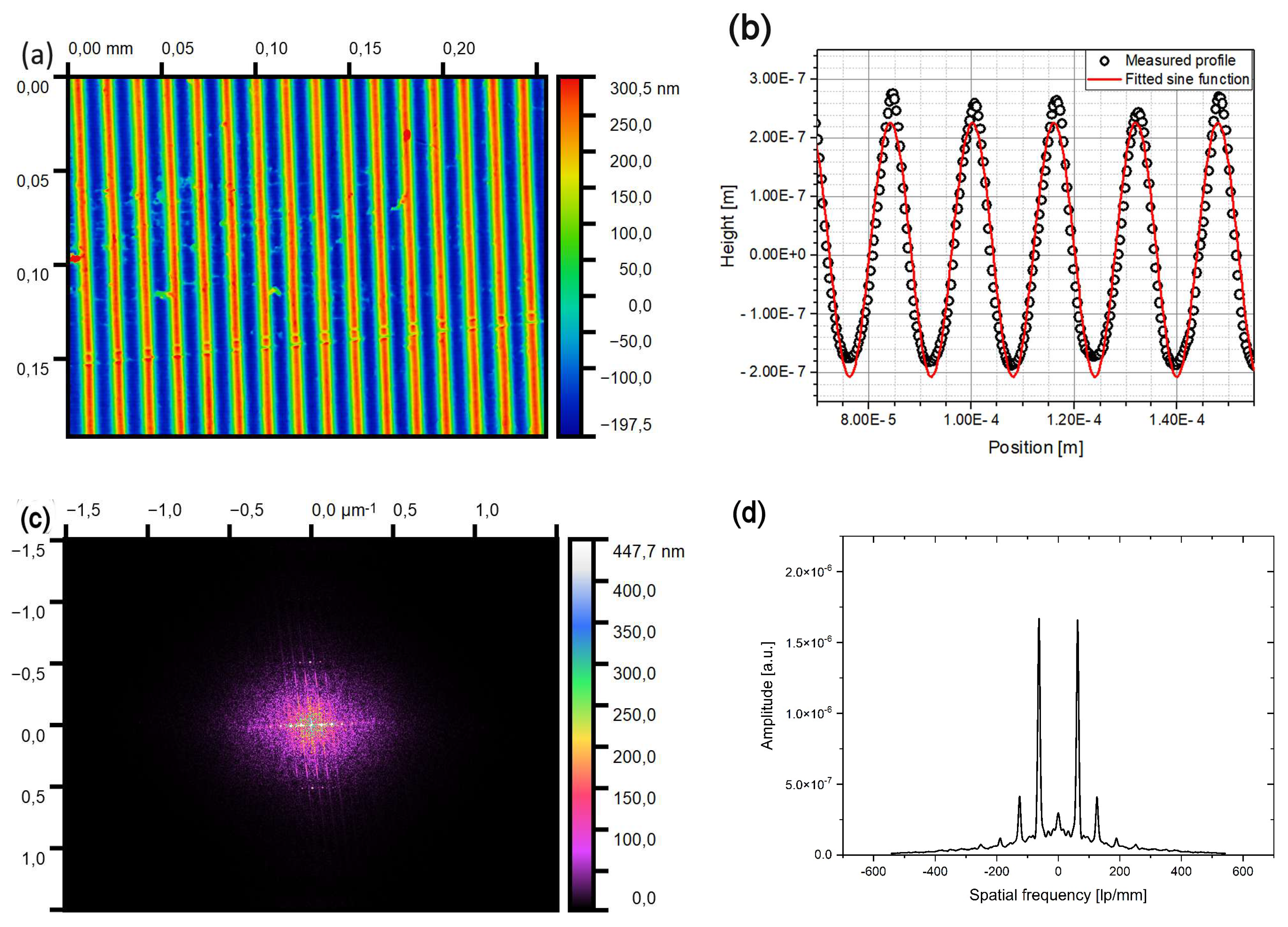
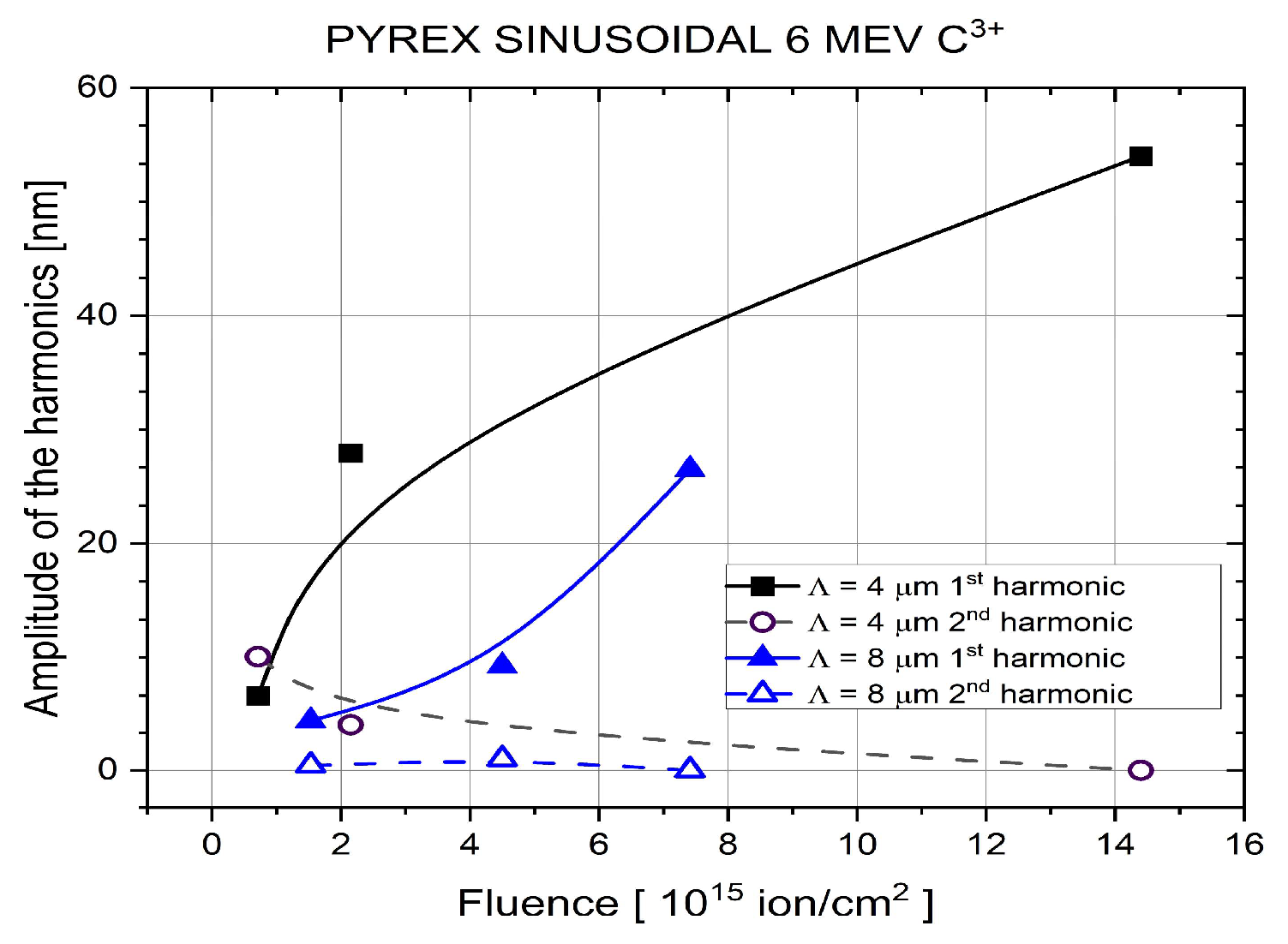
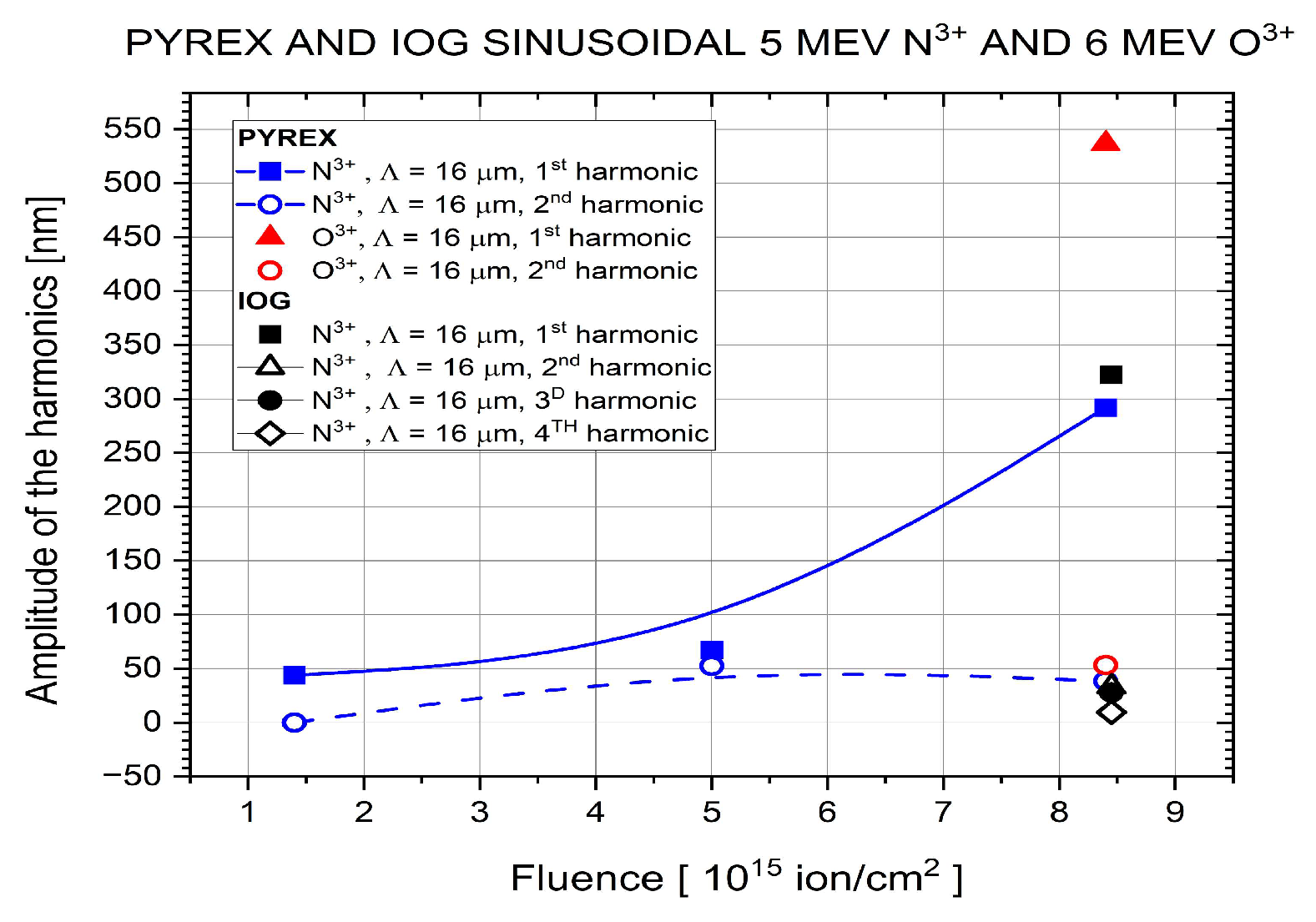

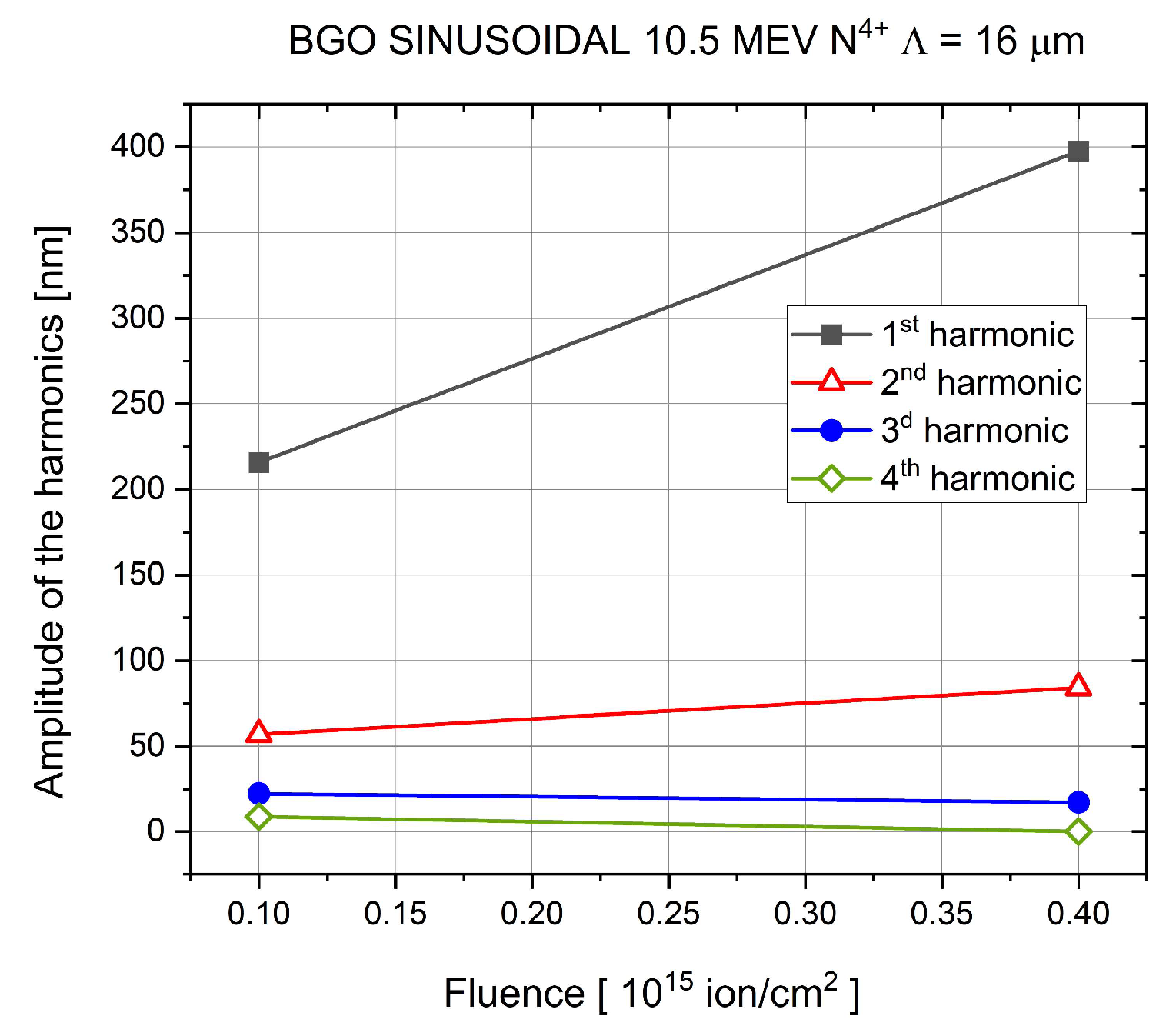
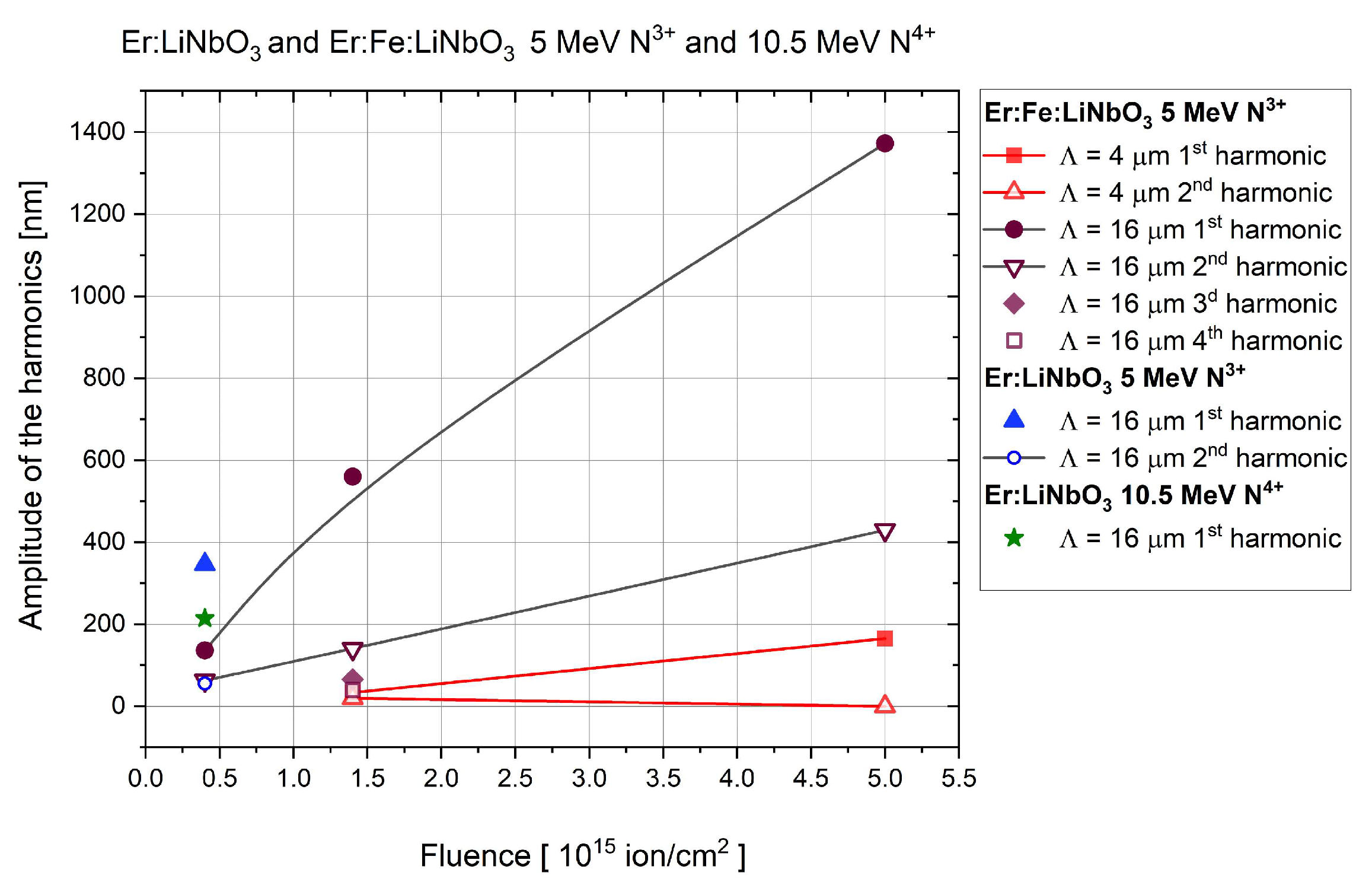
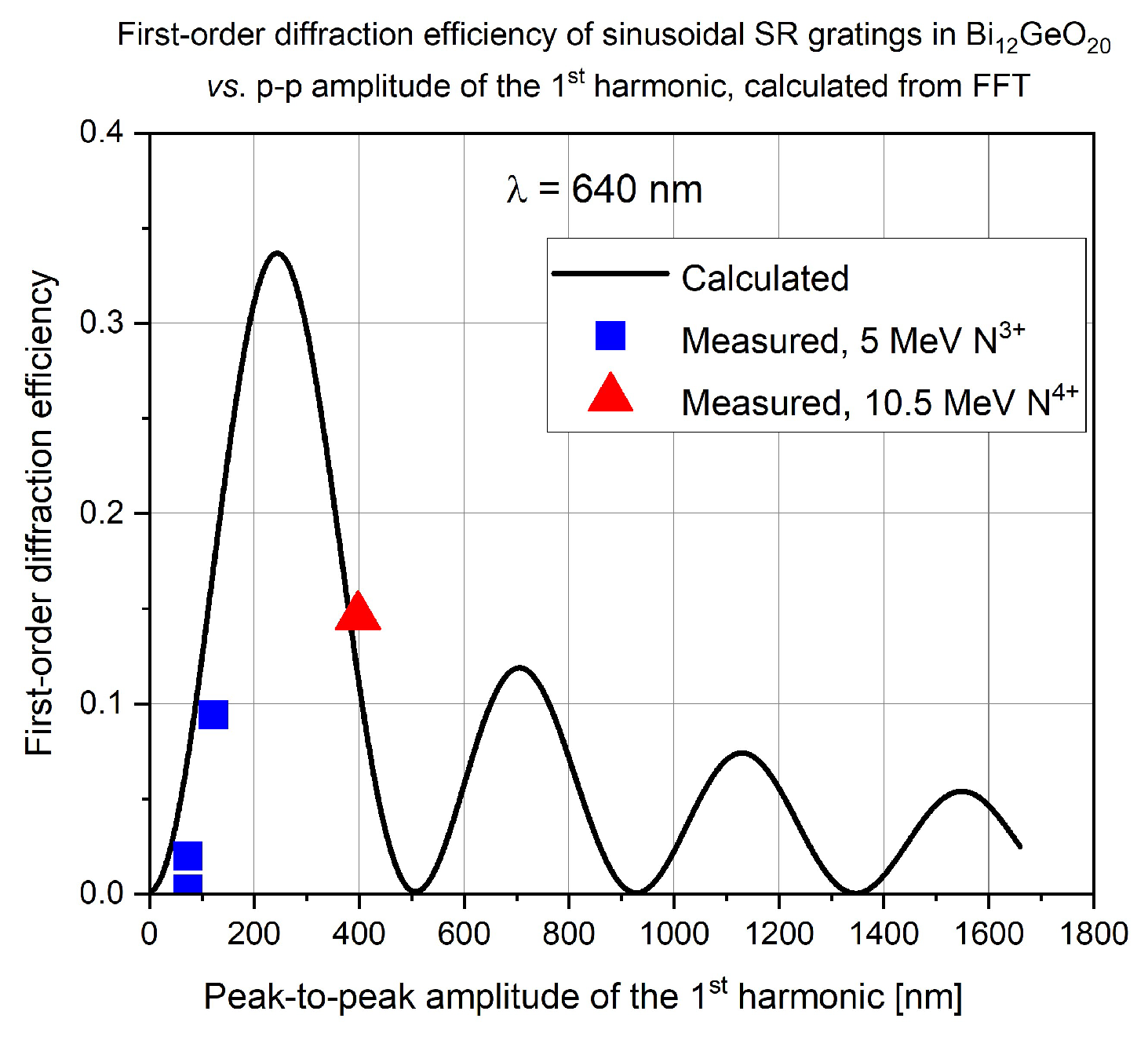
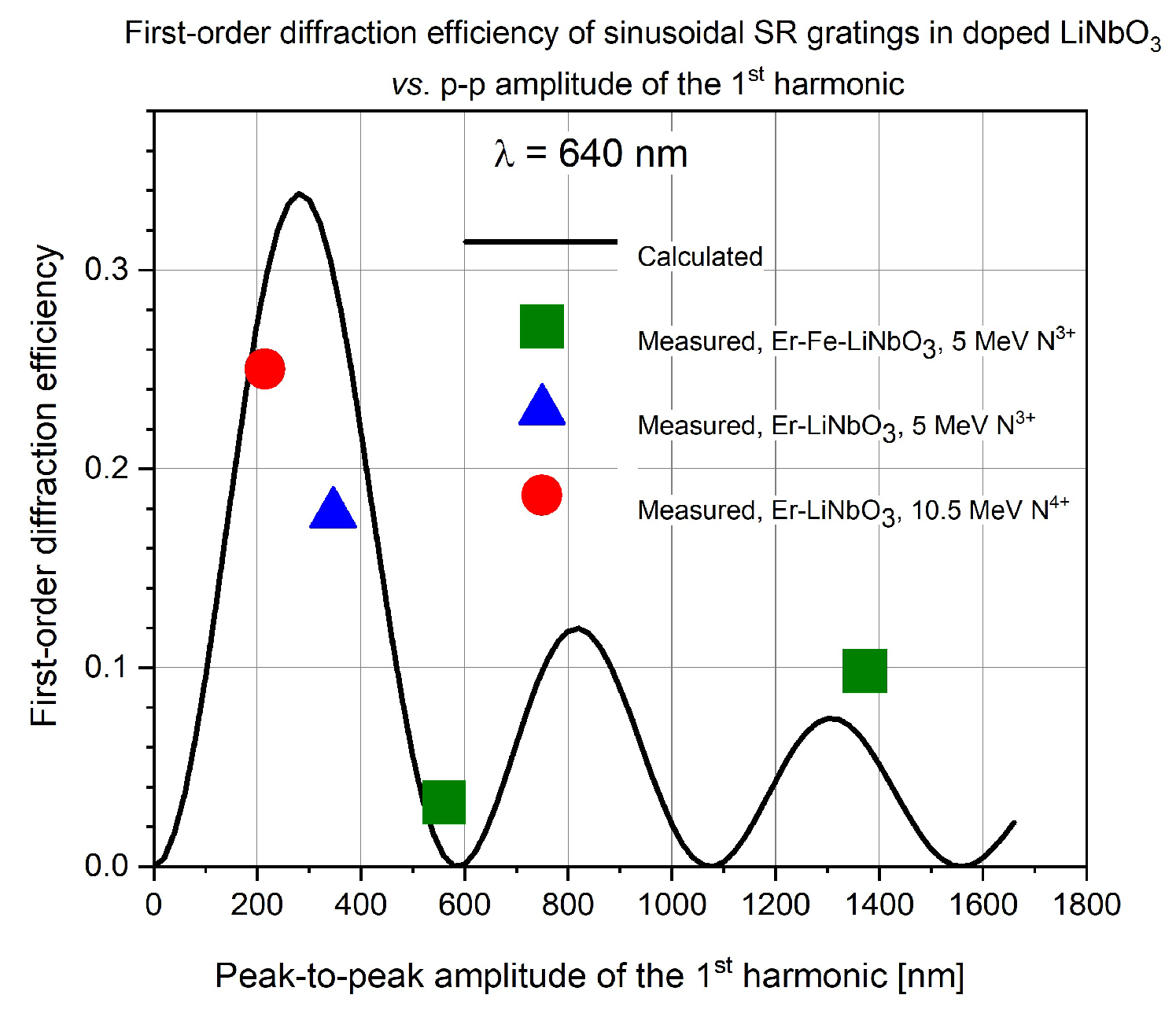
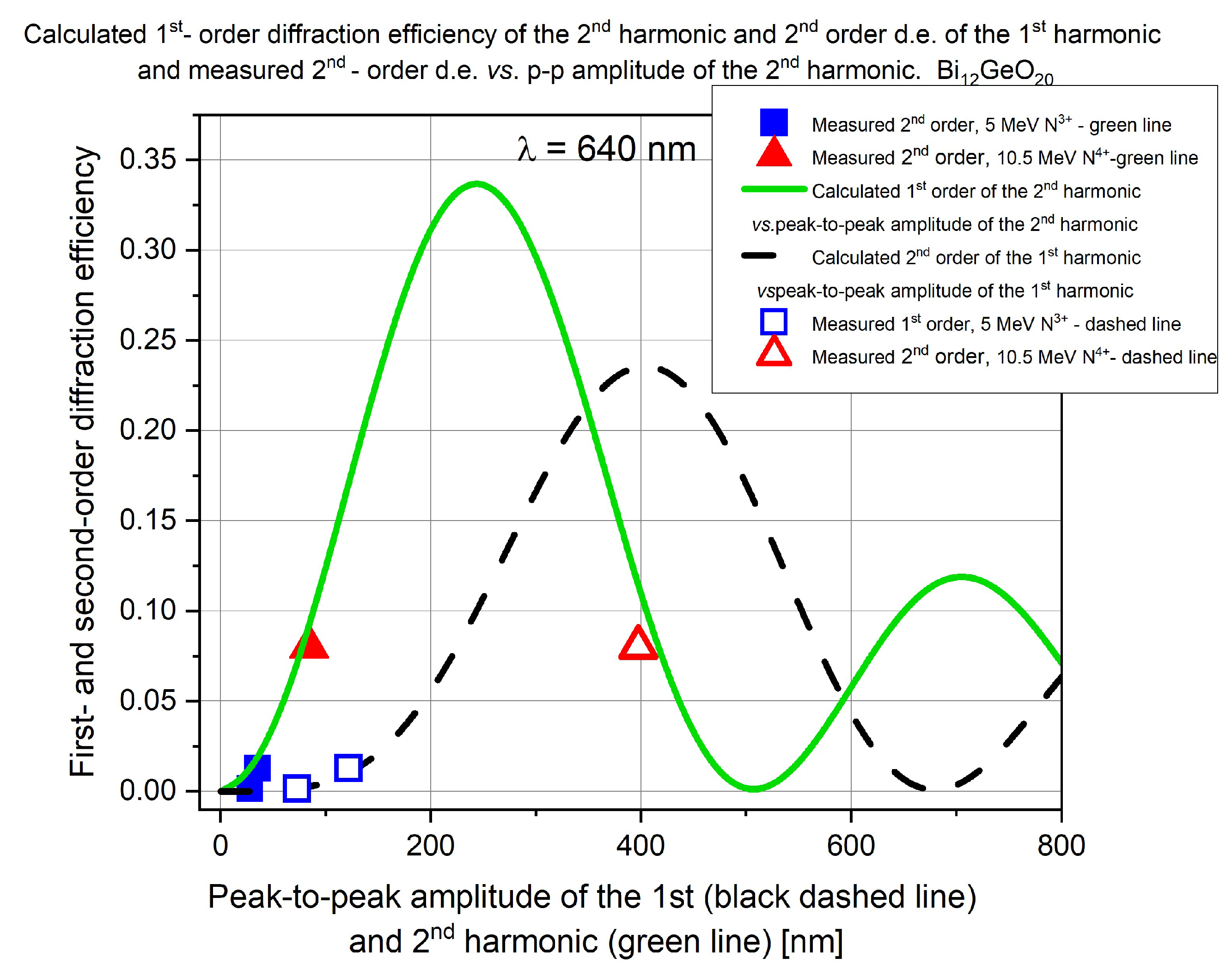
| Name of the Grating Groups | Sample Material | Implanted Ion and Charge State | Ion Beam Energy [MeV] | Ion Beam Lateral Dimensions [μm × μm] | Current Density in the Microbeam [10−3 A/cm2] | Implanted Fluence [ion/cm2] | Grating Constant (Λ) [µm] |
|---|---|---|---|---|---|---|---|
| GE01 | Pyrex glass | C3+ | 6.03 | 2.5 × 4 | 5 | 5.0 × 1014 | 16 |
| GE02 | Pyrex glass | C3+ | 6.03 | 2.5 × 4 | 5 | 3.47 × 1014 | 16 |
| GE03 | Pyrex glass | C3+ | 6.03 | 2.5 × 4 | 5 | 3.42 × 1015 | 16 |
| GE04 | Pyrex glass | C3+ | 6.03 | 2.5 × 4 | 5 | 1.53 × 1015 | 8 |
| GE05 | Pyrex glass | C3+ | 6.03 | 2.5 × 4 | 5 | 4.5 × 1015 | 8 |
| GE06 | Pyrex glass | C3+ | 6.03 | 2.5 × 4 | 5 | 7.41 × 1015 | 8 |
| GE09 | Pyrex glass | C3+ | 6.03 | 2.5 × 4 | 5 | 7.41 × 1015 | 8 |
| GE10 | Pyrex glass | C3+ | 6.03 | 2.5 × 4 | 5 | 7.15 × 1014 | 4 |
| GE11 | Pyrex glass | C3+ | 6.03 | 2.5 × 4 | 5 | 2.15 × 1015 | 4 |
| GE12 | Pyrex glass | C3+ | 6.03 | 2.5 × 4 | 5 | 1.44 × 1016 | 4 |
| GF2 | Pyrex glass | O4+ | 6 | 3 × 20 | 4.17 | 8.4 × 1015 | 16 |
| GF4 | Pyrex glass | N3+ | 5 | 2.5 × 30 | 1.07 | 8.4 × 1015 | 16 |
| GG | IOG glass | N3+ | 5 | 2.5 × 30 | 1.73 | 8.45 × 1015 | 16 |
| GJ02 | Pyrex glass | N3+ | 5 | 3 × 20 | 1.2 | 8.3 × 1014 | 16 |
| GJ04 | Pyrex glass | N3+ | 5 | 3 × 20 | 1.2 | 1.67 × 1014 | 16 |
| GJ06 | Pyrex glass | N3+ | 5 | 3 × 20 | 1.2 | 6.24 × 1013 | 16 |
| GR | Bi12GeO20 crystal | N3+ | 5 | 4 × 4 | 0.70 | 4 × 1014 | 16 |
| GS | Bi12GeO20 crystal | N3+ | 5 | 4 × 4 | 0.70 | 1 × 1014 | 16 |
| GZ08 | Bi12GeO20 crystal | N4+ | 10.5 | 4 × 4 | 1.25 | 4 × 1014 | 16 |
| GZ09 | Bi12GeO20 crystal | N4+ | 10.5 | 4 × 4 | 1.25 | 1 × 1014 | 16 |
| GH | Bi12GeO20 crystal | N4+ | 10.5 | 2.5 × 10 | 0.57 | 4 × 1014 | 16 |
| GL1 | Er:Fe:LiNbO3 crystal | N3+ | 5 | 2.5 × 20 | 0.57 | 5 × 1015 | 4 |
| GL2 | Er:Fe:LiNbO3 crystal | N3+ | 5 | 3 × 20 | 0.57 | 5 × 1015 | 16 |
| GL4 | Er:Fe:LiNbO3 crystal | N3+ | 5 | 3 × 20 | 0.57 | 1.4 × 1015 | 16 |
| GL6 | Er:Fe:LiNbO3 crystal | N3+ | 5 | 3 × 20 | 0.57 | 4 × 1014 | 16 |
| GV | Er:LiNbO3 crystal | N3+ | 5 | 4 × 4 | 0.57 | 4 × 1014 | 16 |
| GW | Er:LiNbO3 crystal | N3+ | 5 | 4 × 4 | 0.57 | 1 × 1014 | 16 |
| GZ04 | Er:LiNbO3 crystal | N4+ | 10.5 | 4 × 4 | 1.0 | 4 × 1014 | 16 |
| GZ05 | Er:LiNbO3 crystal | N4+ | 10.5 | 4 × 4 | 1.0 | 1 × 1014 | 16 |
| Sample Material | Grating Constant (Λ) [µm] | Implanted ion and Charge State | Ion Energy [MeV] | Current Density [10−3 A/cm2] | A1/A2 F = 1.0 × 1014 | A1/A2 F = 4 × 1014 | A1/A2 F = 1.4 × 1015 | A1/A2 F = 4 × 1015 | A1/A2 F = 7.5 × 1015 |
|---|---|---|---|---|---|---|---|---|---|
| Pyrex glass | 8 | C3+ | 6.03 | 5 | 10.3 | 9.25 | 18.5 | ||
| Pyrex glass | 4 | C3+ | 6.03 | 5 | 5 | 15 | 38 | ||
| Pyrex glass | 16 | O4+ | 6 | 4.17 | 10.1 | ||||
| Pyrex glass | 16 | N3+ | 5 | 1.07 | 10 | 2 | 7.7 | ||
| IOG glass | 16 | N3+ | 5 | 1.73 | 11.6 | ||||
| Bi12GeO20 crystal | 16 | N3+ | 5 | 0.70 | 2.6 | 3.4 | |||
| Bi12GeO20 crystal | 16 | N4+ | 10.5 | 1.25 | 3.8 | 4.7 | |||
| Er:Fe:LiNbO3 crystal | 4 | N3+ | 5 | 0.57 | 9 | ||||
| Er:Fe:LiNbO3 crystal | 16 | N3+ | 5 | 0.57 | 2.4 | 4 | 3.2 | ||
| Er:LiNbO3 crystal | 16 | N3+ | 5 | 0.57 | 5.5 |
Disclaimer/Publisher’s Note: The statements, opinions and data contained in all publications are solely those of the individual author(s) and contributor(s) and not of MDPI and/or the editor(s). MDPI and/or the editor(s) disclaim responsibility for any injury to people or property resulting from any ideas, methods, instructions or products referred to in the content. |
© 2025 by the authors. Licensee MDPI, Basel, Switzerland. This article is an open access article distributed under the terms and conditions of the Creative Commons Attribution (CC BY) license (https://creativecommons.org/licenses/by/4.0/).
Share and Cite
Bányász, I.; Rajta, I.; Havránek, V.; Magnusson, R.; Nagy, G. Fourier Analysis of the Nonlinearity of Surface-Relief Optical Transmission Gratings of Quasi-Sinusoidal Profile Fabricated in Optical Glasses and Crystals by Carbon, Nitrogen and Oxygen Ion Microbeams. Photonics 2025, 12, 978. https://doi.org/10.3390/photonics12100978
Bányász I, Rajta I, Havránek V, Magnusson R, Nagy G. Fourier Analysis of the Nonlinearity of Surface-Relief Optical Transmission Gratings of Quasi-Sinusoidal Profile Fabricated in Optical Glasses and Crystals by Carbon, Nitrogen and Oxygen Ion Microbeams. Photonics. 2025; 12(10):978. https://doi.org/10.3390/photonics12100978
Chicago/Turabian StyleBányász, István, István Rajta, Vladimir Havránek, Robert Magnusson, and Gyula Nagy. 2025. "Fourier Analysis of the Nonlinearity of Surface-Relief Optical Transmission Gratings of Quasi-Sinusoidal Profile Fabricated in Optical Glasses and Crystals by Carbon, Nitrogen and Oxygen Ion Microbeams" Photonics 12, no. 10: 978. https://doi.org/10.3390/photonics12100978
APA StyleBányász, I., Rajta, I., Havránek, V., Magnusson, R., & Nagy, G. (2025). Fourier Analysis of the Nonlinearity of Surface-Relief Optical Transmission Gratings of Quasi-Sinusoidal Profile Fabricated in Optical Glasses and Crystals by Carbon, Nitrogen and Oxygen Ion Microbeams. Photonics, 12(10), 978. https://doi.org/10.3390/photonics12100978






